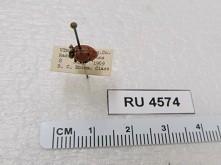- Biology Department
- Pre-Health Advisory Committee
- GIS Center
- Medical Laboratory Science
- Museum of the Earth Sciences
- Mathematics and Statistics
- REALISE
- Chemistry Department
- Radford University Planetarium
- Department of Physics
- Anthropological Sciences
- Geology
- Selu Observatory
- Center for Information Security
- Forensic Science Institute
- Biomedical Science
- Geospatial Science
- School of Computing and Information Sciences
- MS in Data And Information Management
Insect Taxidermy

Methods of preserving insect for museum specimen
by Meron Mengestab
Radford University has over ten thousand insect museum collections from 1940s to as recent as 2012. The collections are still in pristine condition. Two of the main contributors to the collection are entomologists Dr. Hoffman and Dr. Messersmith. These museum specimens were collected mostly from different parts of Virginia and some were from Minnesota, North Carolina, South Carolina, Maryland, New Jersey, New York, West Virginia, Ohio, Tennessee, Florida, and we have some that are from Mexico, Spain and Jamaica.
In order to kill the insects with little to no damage, they can use fumigation method, alcohol or freezing method. Fumigation is used for most of the insect collection in Radford University. Fumigation is done by using a trapping jar. A jar with tight fitting lid that contains sawdust at the bottom soaked in ethyl acetate, acetone, or potassium cyanide. A cardboard with some hole is placed on top of it for the insect to land on it. The fume will rise to the top of the jar.
There are different ways of preserving specimens so they can last for a very long time with very minimal damage. They used two different methods of preserving the insects. Mostly, they used the pinning method. But on a few specimens, they used alcohol to preserve the insects.
For soft-bodied insects, the best way to preserve them is using alcohol. Soft-bodied insects such as termites and larvae can easily shrivel if they dry out. That’s why they should be placed in a clear tube filled with alcohol as soon as they die. We can use two kinds of alcohol. One is ethyl at 45% concentration and the other one is isopropyl alcohol at 70%. For the collections in Radford University, ethyl acetate was used (Key, 1997).
The pinning method is used on insects that have a hard-bodied insect such as bugs and beetles. As seen below in figure 1 the ladybug is pinned using insect pin, which is different than household straight pin or needle. Different sizes of pin can be used depending on how big or small the insect is. To pin the insects without crushing or damaging it, the pin is placed through the right side of the thorax. Inserting the pin through the mid-line of the body where it’s a softer flesh can damage it except for Butterflies and moths. They are exceptions to this rule. They are pinned through the mid-line. Beetles are pinned using their right wing (Key, 1997).
Labeling the specimens is very important. The label should include the name of the specimen, the time and place it was found, and the person that collected it. This helps us easily access the insects and find what they are, where they come from, when they were collected and by whom.
Having all these collections at Radford University has a huge benefit for students. They can learn how to collect and preserve insects. The amount of collection that we have shows the biodiversity. There are about one million known species of insects in the world (Cranston, 2010). Being able to have ten thousand of those specimens in our collection helps students learn hands-on about insects instead of using pictures or videos.
In conservation, museum specimen is one of the methods used to see if a particular species is endemic, if it still exists in the area it was originally found and if it’s extinct. A charismatic species like butterflies or beetles can be used as an umbrella species to protect and preserve other species that use the same habitat (Cranston, 2010).
In conclusion, by using the right material and the correct method, you can collect and preserve insects for a century or more. In doing so, you can document the historical biodiversity of a location.
**************
Photo at top of page: Ladybug (Coccinellidae) was collected on July 8, 1969 by the Radford College Entomology Class from the Radford environs.
Works cited
Cranston,P. S. Gullan, P.J. , (2010). The Insects: An Outline of Entomology. Pp. 2-16.
Key, P.J. (1997). Resource manual for insect collections. White Owl Enterprises. 22p.